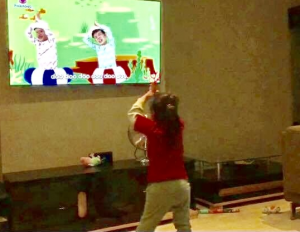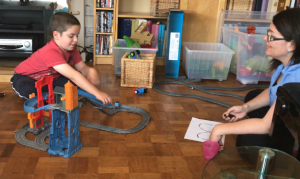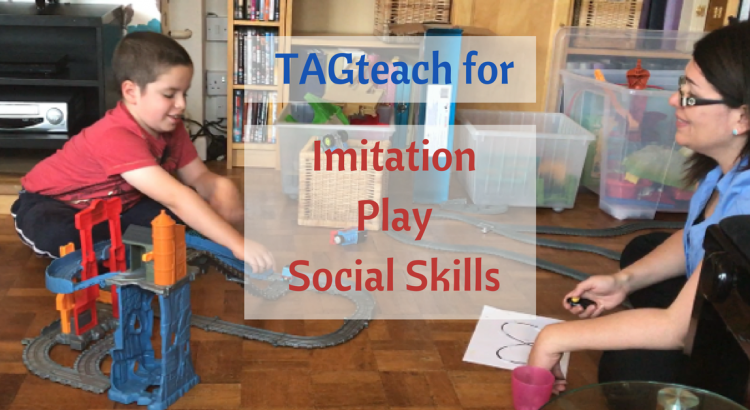By Roni Dunning, B.A., ABA M.Sc., TAGteach Level 2, Blossom ABA
The first time a child performs a skill that they haven’t previously demonstrated is always unforgettable! At Blossom ABA, we’ve been using TAGteach® to help our learners emit spontaneous behaviours in a number of different developmental areas such as imitation, play and social skills. While we use an audible marker, we tend to limit language to teach behaviours that we want to increase in frequency or behaviours that require a chain of steps.
How Does TAGteach Work?
TAGteach enables the teacher to mark a learner’s appropriate behaviour with a sound made using a handheld clicker (or tagger). The tag becomes a conditioned positive reinforcer through association with tangible rewards (access to a preferred toy for example) or praise if the learner finds praise reinforcing. At times, the tag sound can be combined with a small piece of a highly preferred food, a sip of a preferred drink or a token economy system, which helps learners who are being taught skills intensively to understand when they’ve finished that round of teaching and can access a preferred item or activity. We use the terms “reinforcement” and “reinforcing” when referring to things that increase the likelihood that a behavior will happen in future (Skinner, 1957). There is research evidence to support the use of TAGteach and its efficacy in teaching a number of skills, ranging from the teaching of every day tasks to children with autism, movements in sports and to teach surgical procedures to medical students (Jackson, P. A., 2014; Gabler, M., 2013; Fogel et. al, 2010; Levi et. al, 2015).
Shaping vs Prompting
TAGteach works well to help shape spontaneous behaviours and we’ve found it to be much more effective and less intrusive than prompts to teach such skills. A prompt is a type of support given for the learner to perform a behaviour and is known as an antecedent strategy (performed before behaviour happens). Prompts can be verbal (e.g. repeating a request after a tutor), modeling (e.g. clapping and then waiting for a learner to clap), gestural (pointing to a picture we want them to give us after an instruction is given) or physical prompts, for example, providing hand over hand support for learners to perform an action following an instruction such as ‘clap hands’ (Cooper, Heron & Heward, 2007). Although prompts are useful tools when teaching new skills, it is common to find learners who may find physical prompts aversive, leading to inappropriate behaviour happening during teaching sessions and lowering the value of any item or activity they enjoy (Koegel, Egel, 1979). Shaping is a process that doesn’t require any physical touching and so prevents the problems of physical prompting. Shaping can be defined as the use of differential reinforcement to produce a series of gradually changing response classes. Each response class is a successive approximation toward a terminal behaviour (Cooper, Heron & Heward, 2007). Examples of steps towards the action of jumping would be bending knees down, lifting body upwards, getting on tiptoes etc.
Using TAGteach for Imitation
 For early learners, shaping can be used to teach imitation skills. Most of the learners we work with tend to have profound deficits with imitation skills and the lack of imitation poses a huge barrier to learning (Rogers, 2010). For very early learners who are being taught through play, we tend to exaggerate our actions, our facial expressions and tone of voice whilst playing with items to highlight the actions we want them to imitate. Following our own actions, we give learners a chance to copy us, then we tag immediately when they copy us independently. We provide them with a reinforcer that fades quickly such as bubbles, a very small piece of a preferred edible or a sip of a favourite drink. As most of our learners are on intensive teaching programmes, we find that pairing the tag sound with a tangible reinforcer (something that they already like) helps to increase the frequency of behaviours we are trying to teach more efficiently. Other ways to teach spontaneous behaviour involve tagging every time a child spontaneously joins us in an activity peers are doing in the classroom or joins therapists and carers in activities such as playing with blocks or tidying up. As an alternative to a tagger, verbal tags such as ‘yep!’ have been successful to give our learners feedback when they use spontaneous imitation in settings such as school, for example, when learners are successfully following peers around the classroom and playground, and during PE lessons.
For early learners, shaping can be used to teach imitation skills. Most of the learners we work with tend to have profound deficits with imitation skills and the lack of imitation poses a huge barrier to learning (Rogers, 2010). For very early learners who are being taught through play, we tend to exaggerate our actions, our facial expressions and tone of voice whilst playing with items to highlight the actions we want them to imitate. Following our own actions, we give learners a chance to copy us, then we tag immediately when they copy us independently. We provide them with a reinforcer that fades quickly such as bubbles, a very small piece of a preferred edible or a sip of a favourite drink. As most of our learners are on intensive teaching programmes, we find that pairing the tag sound with a tangible reinforcer (something that they already like) helps to increase the frequency of behaviours we are trying to teach more efficiently. Other ways to teach spontaneous behaviour involve tagging every time a child spontaneously joins us in an activity peers are doing in the classroom or joins therapists and carers in activities such as playing with blocks or tidying up. As an alternative to a tagger, verbal tags such as ‘yep!’ have been successful to give our learners feedback when they use spontaneous imitation in settings such as school, for example, when learners are successfully following peers around the classroom and playground, and during PE lessons.
Another advantage of TAGteach is that peers can also be taught to tag learners and help them generalize responses to different people. For learners who are older, the focus may be teaching imitation via functional living skills and we tend to use the Assessment of Functional Living Skills and other supplementary curricula as part of these learners’ programmes (Partington & Mueler, 2012). Imitation and its many variations and dimensions is an extremely important skill to teach and generalize and TAGteach has enabled us assist our learners much more effectively in acquiring these behaviours spontaneously.
Once imitation is established, it becomes easier to expand a learner’s preference for a higher number of items and activities and teach them more complex behaviours and social skills (Ingersoll & Schreibman, 2006). There is research evidence to show that a higher number of socially mediated activities in comparison to other types of preferred items can be an indicator of better intervention outcomes and a better quality of life following intensive ABA programmes (Klintwall & Eikeseth, 2012).
Using TAGteach for Independent Play Skills
 During independent play, a learner may play with one toy or move to different toys within a period of time. There’s no adult involvement or participation from others when a learner’s doing independent play, although initial help from an adult is usually needed. Independent play skills enable someone to keep themselves occupied and carry on activities when others are busy and it’s a very important skill in a person’s life. Examples include very simple puzzles and activities such as putting a Mr. Potato Head together. If a learner can’t play with a toy or activity appropriately, it’s advisable to teach this skill outside independent play, then incorporate it in the list of activities a learner can do after they learn how to play with a specific toy or activity (Ingersoll & Schreibman, 2006).
During independent play, a learner may play with one toy or move to different toys within a period of time. There’s no adult involvement or participation from others when a learner’s doing independent play, although initial help from an adult is usually needed. Independent play skills enable someone to keep themselves occupied and carry on activities when others are busy and it’s a very important skill in a person’s life. Examples include very simple puzzles and activities such as putting a Mr. Potato Head together. If a learner can’t play with a toy or activity appropriately, it’s advisable to teach this skill outside independent play, then incorporate it in the list of activities a learner can do after they learn how to play with a specific toy or activity (Ingersoll & Schreibman, 2006).
We’ve used a tagger to mark when a learner successfully modelled play after us, e.g. when they made successful attempts to set up a play activity independently and when they’ve varied their actions during play. In ABA we use lag schedules to teach variability in behaviour and we’ve found that this has been a very useful schedule when teaching play skills. The application of a lag schedule requires reinforcement provided for responses that differ from a previous response, or from a number of previous responses (Lee, McComas and Jawor, 2002). One example is if a child is playing with a train and we’re working on a lag0 (lag zero) schedule, we’ll reinforce initially if they repeat the action of putting the train on the track. Once this is established, we may move the schedule to a lag1 (lag one), and will reinforce a behaviour that’s different from putting the train on the track. At times, we may not use a lag schedule strictly but be mindful to reinforce behaviours that are different from the previous behaviours during play, keeping play natural and functional for the learner rather than strictly tied to certain levels of variability. We’ve seen learners stop and look at us when they don’t hear the sound of the tagger and then change their behaviour within the same type of play subsequently in order to obtain a tag! We’ve used TAGteach to provide our learners with feedback under these different schedules and we’ve seen excellent results with variability in functional play behaviours.
Here’s a video that shows this in action:
Sammy is learning to play independently and more importantly to enjoy his independent play. At first the therapist reinforced the individual components of play in sessions previous to this one. Now she is reinforcing behavior that is different from a previous behavior. This prevents the formation of repetitive play patterns and encourages more creative play. Sammy’s reinforcement is the click sound made by a handheld tagger. For each tag he gets a penny on the chart and when the chart is full he will get to engage in a preferred activity – going to the skate park. Sammy is tag savvy and he knows that the tag signals a correct behavior. You can see him sometimes look to see if he’s getting and tag and he checks to make sure that he’s getting the penny counter. This is a great way to incorporate reinforcement into independent play without interrupting the play with cheerleading or candy. He is not distracted with instructions, commentary or attention from the therapist and so he is learning the skills of independent play. The social praise and verbal response from the therapist comes only at the end of the session. The goal is to have Sammy learn to play and to enjoy the play for it’s own sake. You can see that starting to happen at the end when he continues to play with the train even though he has earned all tokens in order to access his reinforcer.
Using TAGteach for Social Play
 Social play involves another person or other people. With early learners, we use social play to teach individuals how to interact with others and develop prerequisites for social skills. We work on skills like functional play, spontaneous imitation (Ingersoll, Schreibman, 2006), pro-social behaviours such as eye contact (Carbone, et. al, 2013) social referencing, joint attention (Taylor, Hoch, 2008; Krstovska-Guerrero, Jones, 2013), social initiations (e.g. coming towards an adult in a bid for attention) and, as with independent play, we use facial expressions and exaggerated actions in order to keep the learner engaged. We keep their levels of motivation high which encourages them to participate in fun activities.
Social play involves another person or other people. With early learners, we use social play to teach individuals how to interact with others and develop prerequisites for social skills. We work on skills like functional play, spontaneous imitation (Ingersoll, Schreibman, 2006), pro-social behaviours such as eye contact (Carbone, et. al, 2013) social referencing, joint attention (Taylor, Hoch, 2008; Krstovska-Guerrero, Jones, 2013), social initiations (e.g. coming towards an adult in a bid for attention) and, as with independent play, we use facial expressions and exaggerated actions in order to keep the learner engaged. We keep their levels of motivation high which encourages them to participate in fun activities.
When teaching social skills, we’ll always look at all pro-social behaviours that are prerequisites for social interactions, break them down and tag when approximations of these behaviours happen during activities that are fun for the learner. One example is that we tag episodes of eye contact during play, or any time a child will give us feedback of any kind following our comments whilst they’re playing (e.g. doll sleeping!) or spontaneous approximation to peers and adults around them. We tend to teach behaviours that are required for building joint attention skills by tagging when the learner turns their head towards toys we’re holding or when they notice us interacting with another person, for example, giving another person a high five (Taylor & Hoch, 2008).
Parent Involvement with Tagging
Involving parents, carers and siblings and teaching them these techniques has also enabled them to carry on recommendations given by the ABA consultant after session time and at the weekends. This ensures that there’s consistency in our teaching.
Efficient, Time Effective and Simple
These ABA techniques with the addition of a tag have proved to be a very efficient, time effective and simple way to teach our learners imitation, play and social behaviours and it has enabled us to shape these behaviours without physical prompting or the need to use too much language (at times no language whatsoever!), whilst providing learners with immediate feedback whenever spontaneous behaviour happens.
Less nagging, more tagging!!!
By Roni Dunning, B.A. ABA MSc
TAGteach Level 2
Blossom ABA
References
Carbone, V. J. (2013). The Establishing Operation and Teaching Verbal Behaviour. The Analysis Of Verbal Behaviour, 29, 0-5.
Carr, J. E., Nicolson, A. C., & Higbee, T. S. (2000). Evaluation O of a Brief Multiple-Stimulus Preference Assessment in a Naturalistic Context. Journal of Applied Behavior Analysis, 33 (3), 353-357.
Cooper, J. O., Heron, T. E., & Heward, W. L. (1987). Applied Behavior Analysis. Columbus, OH.
Fogel, V., Wiel, T. M., Burns, H. (2010). Evaluating the Efficacy of TAGteach as a Training Strategy for Teaching a Golf Swing. Journal of Behavioural Health Medicine. 1, 24-41.
Gabler, M. (2013). Chaos To Calm: Discovering Solutions to the Everyday Problems of Living with Autism. Tagteach International, Waltham, MA.
Ingersoll, B., Schreibman, L.. (2006). Teaching Reciprocal Imitation Skills to Young Children with Autism Using a Naturalistic Behavioural Approach: Effects on Language, Pretend Play, and Joint Attention. Journal Of Autism And Developmental Disorders, 36:487.
Jackson, P. A., (2014). An Evaluation of Tagteach Components to Decrease Toe-Walking in A 4 Year Old Child with Autism. Journal of Autism and Developmental Disorders. 44 (4), 965-8.
Klintwall, L., Eikeseth, S. (2012). Number and Controllability of Reinforcers as Predictors of Individual Outcome for Children with Autism Receiving Early And Intensive Behavioral Intervention: A Preliminary Study. Research in Autism Spectrum Disorders, 6, 493-499.
Koegel R.L., Egel, A. L. (1979). Motivating Autistic Children. Journal of Abnormal Psychology, 88, 418-426.
Krstovska-Guerrero, I., Jones, E. A. (2013). Joint Attention in Autism: Teaching Smiling Coordinated with Gaze to Respond to Joint Attention Bids. Research In Autism Spectrum Disorders. 7 (1), 93-108.
Lee, R., McComas, J. J., Jawor, J. (2002). The Effects of Differential and LAG Reinforcement Schedules on Varied Verbal Responding by Individuals with Autism. Journal of Applied Behavior Analysis, 35 (4), 391-402.
Levi, I. M., Pryor, K. W. and McKeon, T. R. (2015). Is Teaching Surgical Skills Using an Operant Learning Program More Effective Than Teaching by Demonstration? Clinical Orthopaedics and Related Research.
Partington, J., Mueller, M. (2012). The Assessment of Functional Living Skills. Pleasant Hill, CA: Behavior Analysts, Inc.
Rogers, S., Dawson, G. (2010). Early Denver Start Model for Young Children with Autism. The Guildford press, new york.
Skinner, B. F. (1957). Verbal behavior. New York: Appleton-Century-Crofts
Taylor, B. A., Hoch, H. (2008). Teaching Children with Autism to Respond to and Initiate Bids for Joint Attention. Journal of Applied Behaviour Analysis, 41 (3), 377-391.
Click here to view the complete TAGteach reference list: https://docs.google.com/document/d/1kTBHw_s198Nyn1EiwTQ9hsY08BpsQpyNYc6jsx0NVnw
About Roni
 Roni Dunning has a teaching background and worked in a variety of higher education settings in the last 20 years. Roni has worked in Brazil and the UK and her experience includes teaching children and adults of all ages and backgrounds, administration and research settings.
Roni Dunning has a teaching background and worked in a variety of higher education settings in the last 20 years. Roni has worked in Brazil and the UK and her experience includes teaching children and adults of all ages and backgrounds, administration and research settings.
Roni has a son diagnosed with Autism Spectrum Disorder (ASD) and, in 2011, she put her career on hold to set up his ABA programme as a full time carer, when he was nearly 5 years old. ABA has given Roni the tools to teach her son effectively, which she had not been able to do before, despite her teaching experience. From seeing her son’s progress and supporting and training his ABA team, she acquired experience in setting up new ABA programmes, training therapists and supporting families who wish to pursue funding from their local authorities.
Roni started as an ABA practitioner in 2012 and is currently supervising and running ABA programmes across the UK. She finished her masters in Behaviour Analysis & Therapy, at the University of South Wales in 2016. She has also finished her supervised practice hours and will be taking her BCBA exam soon.
Alongside ABA therapy, Roni has a special interest in ABA research, teaching, staff training and Acceptance and Commitment Therapy.
About Blossom ABA
Blossom ABA is one of the first ABA service provider outside North America to apply TAGteach extensively.
Blossom ABA is run by Veronica Dunning, Applied Behaviour Analysis Consultant and autism mum.
Roni offers a client centred service of high quality and she invests in excellent quality training to cater for her client needs in line with the latest research. She works with families, schools, autism centres and other services and organisations as required.
Learn More About TAGteach FREE Online

